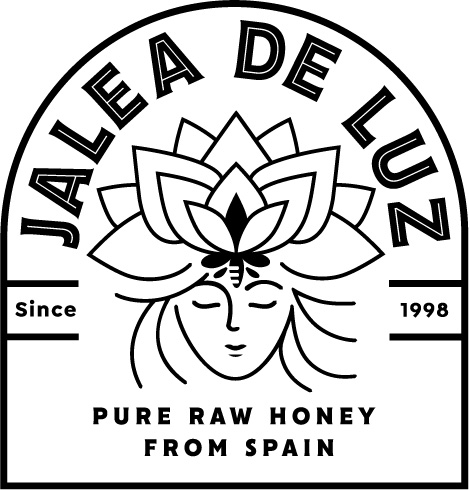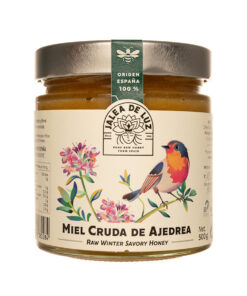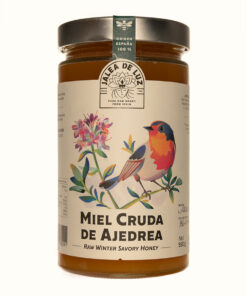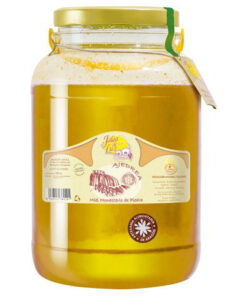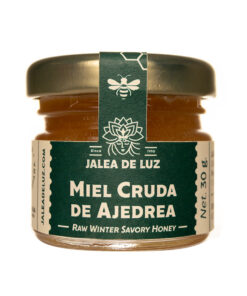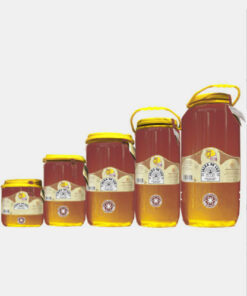Savory Honey
Origin : Spain and other areas of the Iberian PeninsulaRepresentative Specie: Savory (Satureja spp).
Mayority floral composition: savory (Satureja spp), thyme (Thymus vulgaris L), Carrasca( Quercus L.), Sage (Salvia officinalis L.) and Lavender(Lavandula angustifolia ).
Production period: summer to early autumn.
Color : multicromatic varied Amber.
Taste : sweet and delicate, semi intense.
Aroma : superior, intensely aromatic and scented.
Peculiarities: raw honey, pure, not homogenized, not filtered, without added sugars.
Conservation : keep dry, semi-dark and cool.
** In its natural process, honey crystallizes and hardens according to various parameters (temperature, floral origin, etc.
Characteristics of Savory Honey
Savory Honey is one of the most aromatic and consistent pure natural honeys, since in its essential route, it is usually accompanied by intensely fragrant plants such as thyme, rosemary, sage, lavender, etc.. which accumulate rich essence in rocky terrain of the middle Aragonese mountain.It has a broad content of pollen and nectar of flowers of various aromatic species (savory, rosemary, thyme, lavender,..), as well as myelatos of chaparros shrubs (carrasca,..).
It comprises a wide range of Amber natural colors very variable depending on the floral predominance of the moment. Excellent delicate flavor, semi intense, compendium of many mountain sensations, seasoned occasionally by the strength of the late myelatus aguerrides that increase their organoleptic qualities to higher ranges.
Highlights its supreme aroma intensely aromatic and scented, characteristic of the varietal amalgam of the area that provides honeydew of excellent quality.
Savory Honey Excellencies
The selected natural Savory Honey collected by our bees, as well as the rest of the melliferous products of the hive (pollen, propolis, royal jelly,..), meets all the healthy requirements to be a natural product of incredible value:• Raw: it has not been subjected to processes of overheating (more than 40 degrees) or pasteurization; in this way, we manage to keep all vitamins, nutrients and enzymes immaculate, in addition to their extraordinary taste and olfactory qualities.
• Non-homogenized: we never mix or homogenize natural honeys from different geographical or floral areas, because our permanent goal is to maintain the essence and purity throughout the handling process.
• Pure: it is produced by bees through the natural process of libation of pollen, nectar and secretions of sucking plants and insects, and then processed and stored in the honeycombs inside the hive; it is a productive order devoid of the influence of factors other than those that nature itself provides
• Unfiltered: it is the guarantee for the permanent preservation of all the natural qualities of origin and thus obtain a unique natural product.
• No added sugars: contains only healthy natural sugars typical of unadulterated natural honey.
Usage tips
The natural Savory Honeys collected by our bees have unique characteristics, so it is advisable to take them directly, savoring them inside the mouth as long as possible before ingesting them. To make them more manageable in those cases that are preferred diluted, it is recommended at most, warm the "bain-marie" to temperature that never exceeds 40 º to avoid the loss of qualities.Conservation tips
Keep in a dry, semi-dark and cool place to keep intact in a natural way all its qualities.Where does it come from?
This exquisite and traditional Savory Honey, is produced by the Bee as a result of the libation when extracting pollen and nectar from the flowers of species such as savory (Satureja spp), thyme (Thymus vulgaris L), sage (Salvia officinalis L.), lavender (Lavandula angustifolia ), native wild flora varied from the Aragonese forest, and late myelates coming mostly from the secretions of carrascas (Quercus L.) and some sucking insects located in areas of under Aragonese.Among this range of eminently aromatic vegetables, the savory is the most representative species, being a harmoniously branched semi-woody plant with a semi-carousel (30-40 cm high), opposite leaves lanceolate greyish green, typical flowers of whitish colors and fruit as Angular achene.
